Mechanism of Novel K2SO4/KCl Composite Roasting Additive for Strengthening Vanadium Extraction from Vanadium–Titanium Magnetite Concentrate
Abstract
1. Introduction
2. Experimental
2.1. Materials
2.2. Procedure and Methods
3. Results and Discussion
3.1. Effect of Different Composite Additives and Their Mass Ratio on Vanadium Leaching Efficiency
3.2. Effect of Additive Dosage on Vanadium Leaching Efficiency
3.3. Effect of Roasting Temperature and Time on Vanadium Leaching Efficiency
3.4. Mechanism of Composite Roasting Additive on Extracting Vanadium
3.4.1. Crystal Transformation of Vanadium-Bearing Magnetite in the Roasting Process
3.4.2. Synergistic Effect of Composite Roasting Additive
4. Conclusions
- The vanadium leaching efficiency of 82.04% was obtained, which increased 7.43% compared with single K2SO4 and 10.05% compared with single KCl under the following conditions: the total dosage of K2SO4/KCl was 7 wt % with the mass ratio of 6/4, the roasting temperature was 950 °C, the roasting time was 1 h, the leaching temperature was 95 °C, the sulfuric acid concentration was 10% (v/v), and the leaching time was 1.5 h with the liquid-to-solid ratio of 3 mL/g.
- The essence of the vanadium extraction with roasting was the conversion of vanadium-bearing magnetite to hematite. With the reconstructed transformation of cubic crystal systemic magnetite (FeO(Fe,V)2O3) to trigonal crystal systemic hematite (α-Fe2O3), most Fe(V)–O bonds were broken and V(III) was dissociated out, which was then further oxidized and transformed into soluble vanadate.
- The main decomposition products of the K2SO4/KCl composite roasting additive were K2O, SO2, and Cl2. Meanwhile, the mechanism of K2SO4/KCl for facilitating vanadium extraction was mainly reflected in three aspects. Firstly, highly active K2O could combine with vanadium to generate soluble KVO3 to avoid the formation of insoluble Ca(VO3)2; secondly, SO2 could react with CaO to generate CaSO4 to inhibit the formation of acid-consuming Ca(VO3)2, which is favorable to the dissolution of vanadium-bearing sphene (Ca(Ti,V)SiO4O); thirdly, Cl2 could react with hematite (Fe2O3) to generate volatile FeCl3 to reduce the extent of hematite (Fe2O3) wrapping KVO3.
Author Contributions
Funding
Conflicts of Interest
References
- Zhang, Y.M.; Bao, S.X.; Liu, T.; Chen, T.J.; Huang, J. The technology of extracting vanadium from stone coal in China: History, current status and future prospects. Hydrometallurgy 2011, 109, 116–124. [Google Scholar] [CrossRef]
- Skyllaskazacos, M.; Cao, L.Y.; Kazacos, M.; Kausar, N.; Mousa, A. Vanadium electrolyte studies for the vanadium redox battery—A review. ChemSusChem 2016, 9, 1521–1543. [Google Scholar] [CrossRef] [PubMed]
- Han, J.L.; Zhang, Y.M.; Liu, T.; Huang, J.; Xue, N.N.; Hu, P.C. Preparation of Vanadium Nitride Using a Thermally Processed Precursor with Coating Structure. Metals 2017, 7, 360. [Google Scholar] [CrossRef]
- Bijelic, A.; Aureliano, M.; Rompel, A. The antibacterial activity of polyoxometalates: Structures, antibiotic effects and future perspectives. Chem. Commun. 2018, 54, 1153–1169. [Google Scholar] [CrossRef] [PubMed]
- Gumerova, N.; Krivosudsky, L.; Fraqueza, G.; Breibeck, J.; Al-Sayed, E.; Tanuhadi, E.; Bijelic, A.; Fuentes, J.; Aureliano, M.; Rompel, A. The P-type ATPase inhibiting potential of polyoxotungstates. Metallomics 2018, 10, 287–295. [Google Scholar] [CrossRef] [PubMed]
- Zhu, X.B.; Li, W.; Tang, S.; Zeng, M.J.; Bai, P.Y.; Chen, L.J. Selective recovery of vanadium and scandium by ion exchange with D201 and solvent extraction using P507 from hydrochloric acid leaching solution of red mud. Chemosphere 2017, 175, 365–372. [Google Scholar] [CrossRef] [PubMed]
- Sui, Y.L.; Guo, Y.F.; Jiang, T.; Xie, X.L.; Wang, S.; Zheng, F.Q. Gas-based reduction of vanadium titano-magnetite concentrate: Behavior and mechanisms. Int. J. Miner. Metall. Mater. 2017, 24, 10–17. [Google Scholar] [CrossRef]
- Xu, C.B.; Zhang, Y.M.; Liu, T.; Huang, J. Characterization and Pre-Concentration of Low-Grade Vanadium-Titanium Magnetite Ore. Minerals 2017, 7, 137. [Google Scholar] [CrossRef]
- Chen, D.S.; Zhao, H.X.; Hu, G.P.; Qi, T.; Yu, H.D.; Zhang, G.Z.; Wang, L.N.; Wang, W.J. An extraction process to recover vanadium from low-grade vanadium-bearing titanomagnetite. J. Hazard. Mater. 2015, 294, 35–40. [Google Scholar] [CrossRef] [PubMed]
- Li, H.Y.; Fang, H.X.; Wang, K.; Zhou, W.; Yang, Z.; Yan, X.M.; Ge, W.S.; Li, Q.W.; Xie, B. Asynchronous extraction of vanadium and chromium from vanadium slag by stepwise sodium roasting—Water leaching. Hydrometallurgy 2015, 156, 124–135. [Google Scholar] [CrossRef]
- Chen, D.S.; Song, B.; Wang, L.N.; Qi, T.; Wang, Y.; Wang, W.J. Solid state reduction of Panzhihua titanomagnetite concentrates with pulverized coal. Miner. Eng. 2011, 24, 864–869. [Google Scholar] [CrossRef]
- Hu, Y.J. Study on Roasting and Leaching Mechanism of Vanadium-bearing Shale with High-calcium Mica. Ph.D. Thesis, Wuhan University of Technology, Wuhan, China, 2012. (In Chinese). [Google Scholar]
- Zhang, X.F.; Liu, F.G.; Xue, X.X.; Jiang, T. Effects of microwave and conventional blank roasting on oxidation behavior, microstructure and surface morphology of vanadium slag with high chromium content. J. Alloys Compd. 2016, 686, 356–365. [Google Scholar] [CrossRef]
- Yang, X.L.; Feng, Y.L.; Li, H.R.; Du, Z.W. Optimization Mechanism of Additive of Composite Sodium Salts on Vanadium Oxidation of Siliceous Shale. Minerals 2017, 7, 103. [Google Scholar] [CrossRef]
- Xiang, J.Y.; Huang, Q.Y.; Lv, X.W.; Bai, C.G. Multistage utilization process for the gradient-recovery of V, Fe, and Ti from vanadium-bearing converter slag. J. Hazard. Mater. 2017, 336, 1–7. [Google Scholar] [CrossRef] [PubMed]
- Xiang, J.Y.; Huang, Q.Y.; Lv, X.W.; Bai, C.G. Extraction of vanadium from converter slag by two-step sulfuric acid leaching process. J. Clean. Prod. 2018, 170, 1089–1101. [Google Scholar] [CrossRef]
- Zhu, X.B.; Li, W.; Guan, X.M. Vanadium extraction from titano-magnetite by hydrofluoric acid. Int. J. Miner. Process. 2016, 157, 55–59. [Google Scholar] [CrossRef]
- Li, R.M.; Liu, T.; Zhang, Y.M.; Huang, J.; Xu, C.B. Efficient Extraction of Vanadium from Vanadium –Titanium Magnetite Concentrate by Potassium Salt Roasting Additives. Minerals 2018, 8, 25. [Google Scholar] [CrossRef]
- Zhu, X.B.; Zhang, Y.M.; Liu, T. Experiment and Mechanism Study on Vanadium Extraction from Stone Coal by Activation Roasting. Chin. J. Rare Met. 2013, 37, 284–288. (In Chinese) [Google Scholar]
- Chen, F.; Zhang, Y.M.; Huang, J.; Liu, T.; Xue, N.N. Mechanism of Enhancing Extraction of Vanadium from Stone Coal by Roasting with MgO. Minerals 2017, 7, 33. [Google Scholar] [CrossRef]
- Wang, B.; Liu, T.; Zhang, Y.M.; Huang, J. Effect of CaF2/CaO Composite Additive on Roasting of Vanadium-Bearing Stone Coal and Acid Leaching Kinetics. Minerals 2017, 7, 43. [Google Scholar] [CrossRef]
- Beijing General Research Institute of Mining & Metallurgy. Chemical Phase Analyses; Metallurgical Industry Press: Beijing, China, 1979; pp. 141–150. (In Chinese) [Google Scholar]
- Gao, Y.M. Determining vanadium content in vanadium-bearing slag with ferrous iron volumetric method. Ferro-Alloys 2003, 3, 44–46. [Google Scholar]
- Zhao, Y.L.; Kang, S.C.; Wang, W.; Zhang, Y.M.; Song, S.X.; Bao, S.X. Decomposition characteristics of compound additive and effect of roasting atmosphere on vanadium extraction from stone coal. Asia-Pac. J. Chem. Eng. 2017, 12, 374–380. [Google Scholar] [CrossRef]
- Yuan, Y.Z.; Zhang, Y.M.; Liu, T.; Chen, T.J. Comparison of the mechanisms of microwave roasting and conventional roasting and of their effects on vanadium extraction from stone coal. Int. J. Miner. Metall. Mater. 2015, 22, 476–482. [Google Scholar] [CrossRef]
- Chen, C. Transformation Mechanism of Iron Minerals in Oolitic Hematite Magnetic Roasting. Master’s Thesis, Northeastern University, Shenyang, China, 2013. (In Chinese). [Google Scholar]
- Babay, S.; Mhiri, T.; Toumi, M. Synthesis, Structural and spectroscopic characterizations of maghemite γ-Fe2O3 prepared by one-step coprecipitation route. J. Mol. Struct. 2015, 1085, 286–293. [Google Scholar] [CrossRef]
- Liao, L.B. Crystal Chemistry and Crystal Physics; Geological Press: Beijing, China, 2000; pp. 107–109. (In Chinese) [Google Scholar]
- Zhao, Y.L. Theoretical Investigation on Roasting Process of Low-Grade Mica-Type Vanadium-Bearing Shale. Ph.D. Thesis, Wuhan University of Technology, Wuhan, China, 2014. (In Chinese). [Google Scholar]
- Zhang, Y.M.; Hu, Y.J.; Bao, S.X. Vanadium emission during roasting of vanadium-bearing stone coal in chlorine. Miner. Eng. 2012, 30, 95–98. [Google Scholar] [CrossRef]
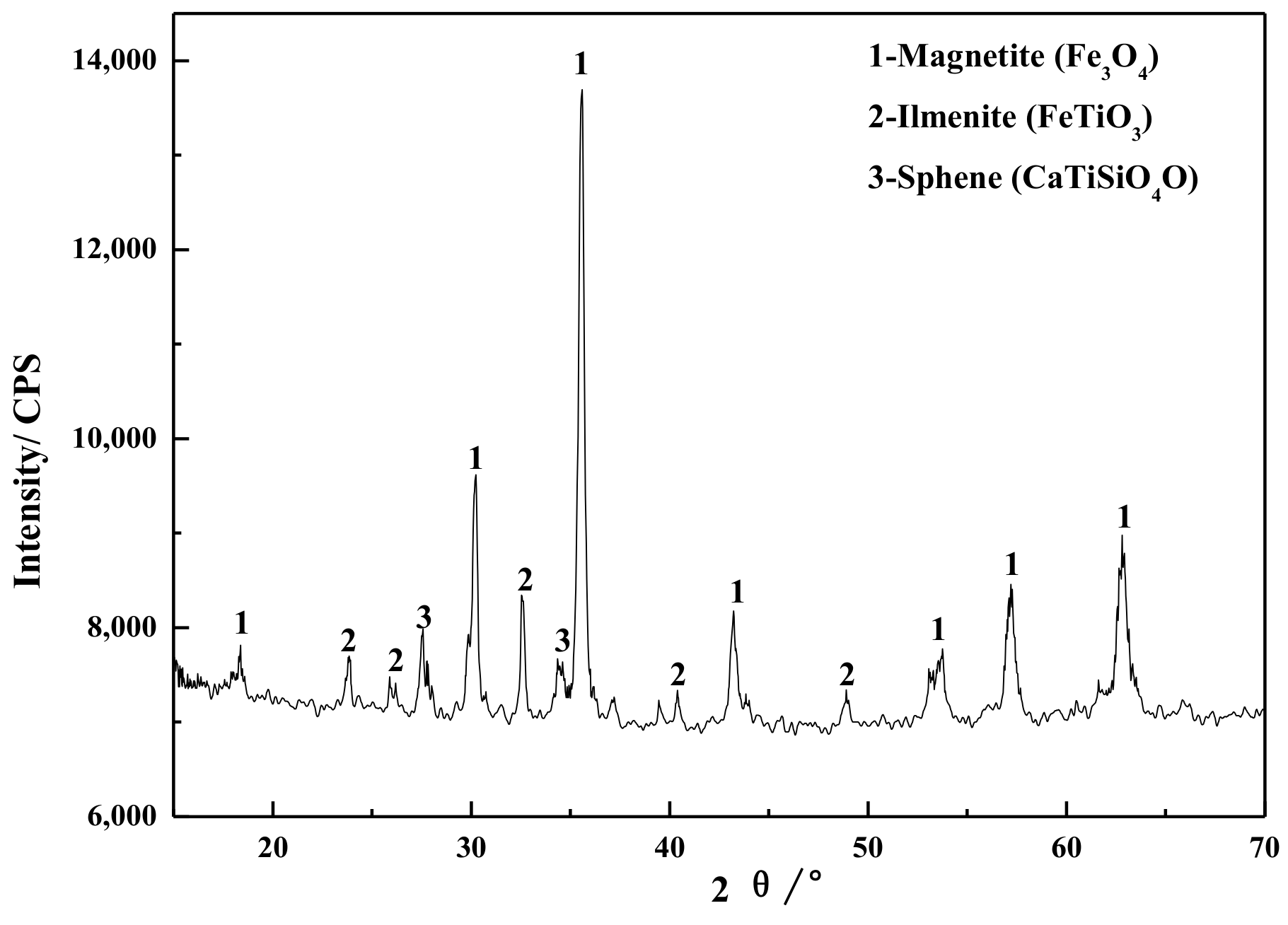
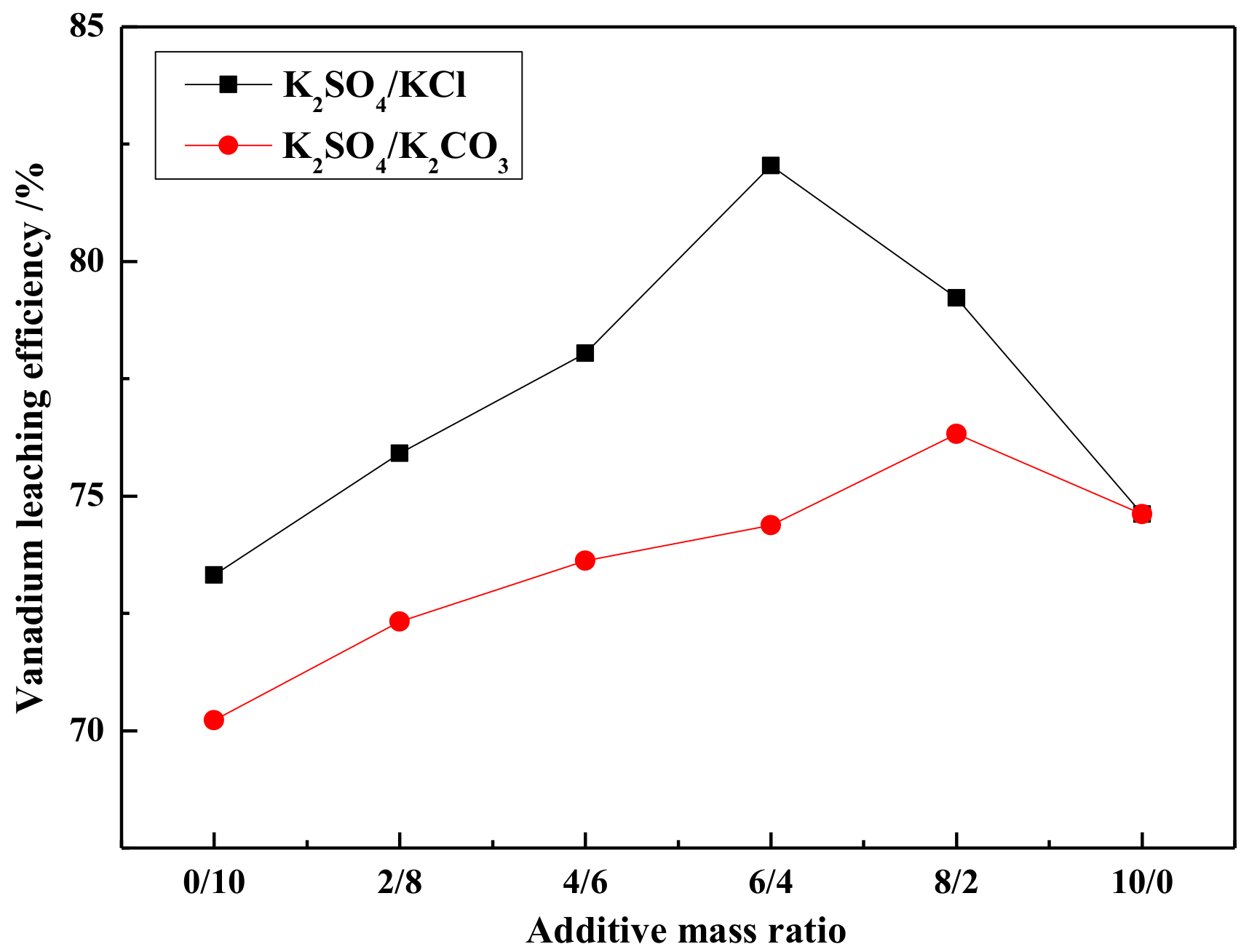
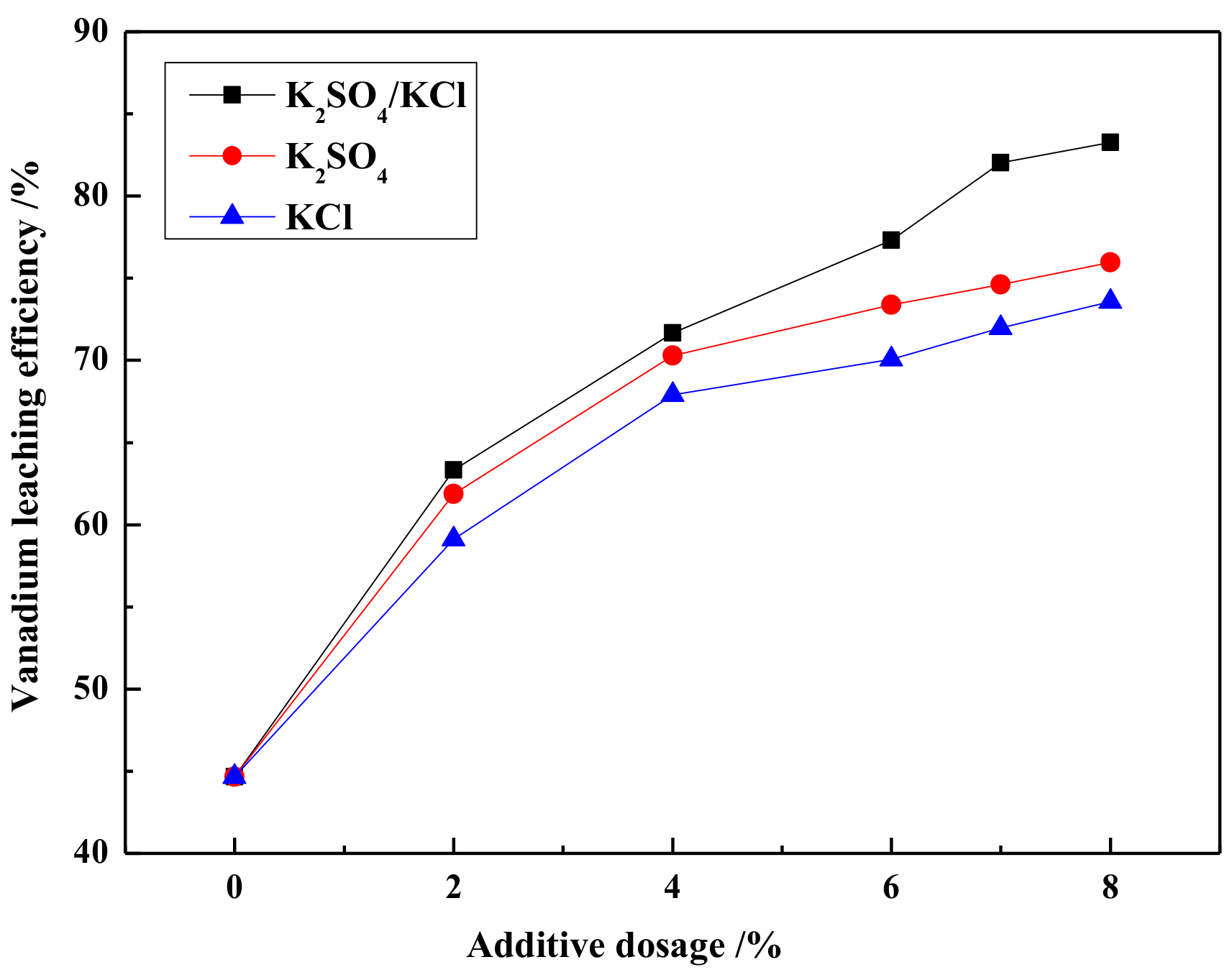
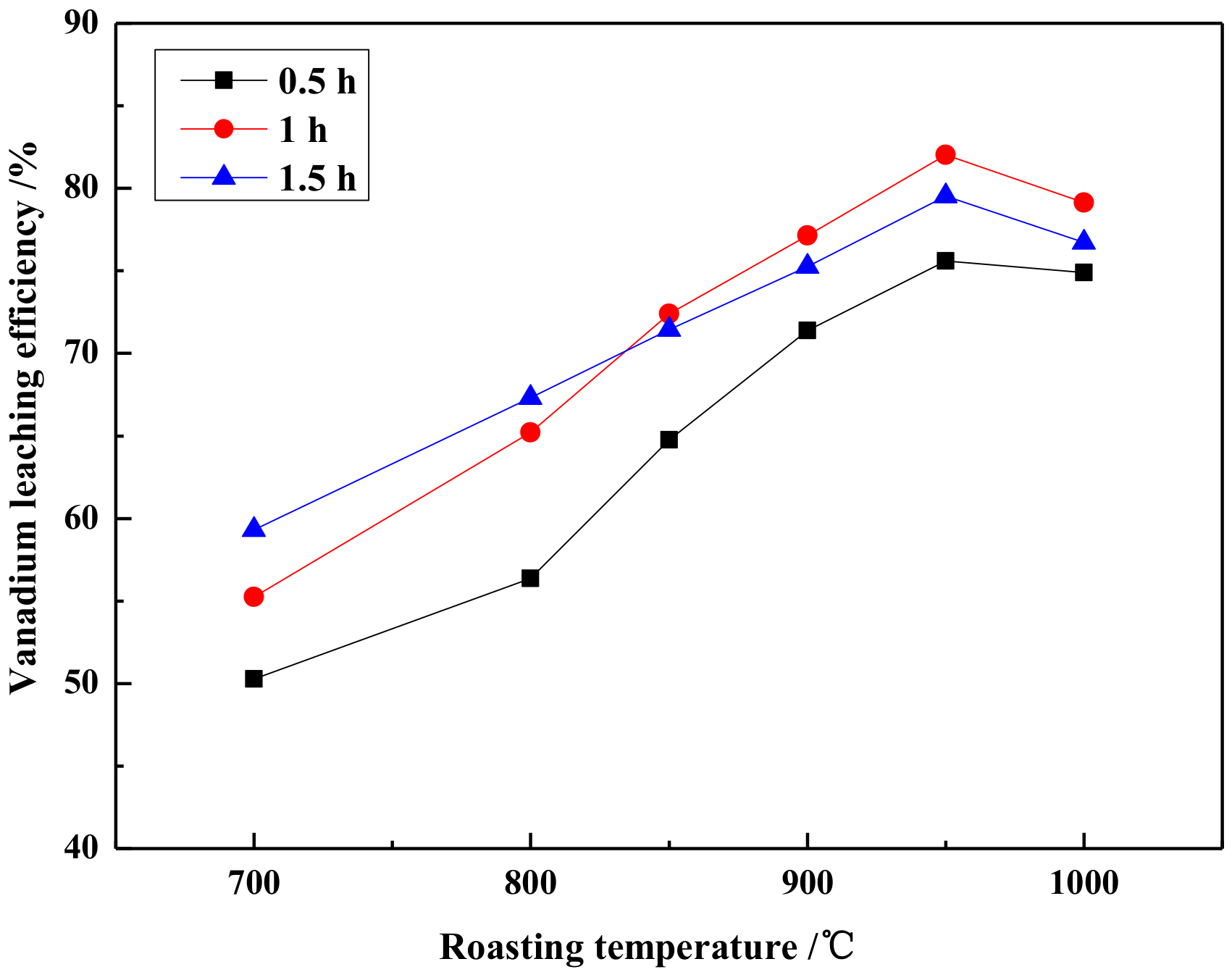


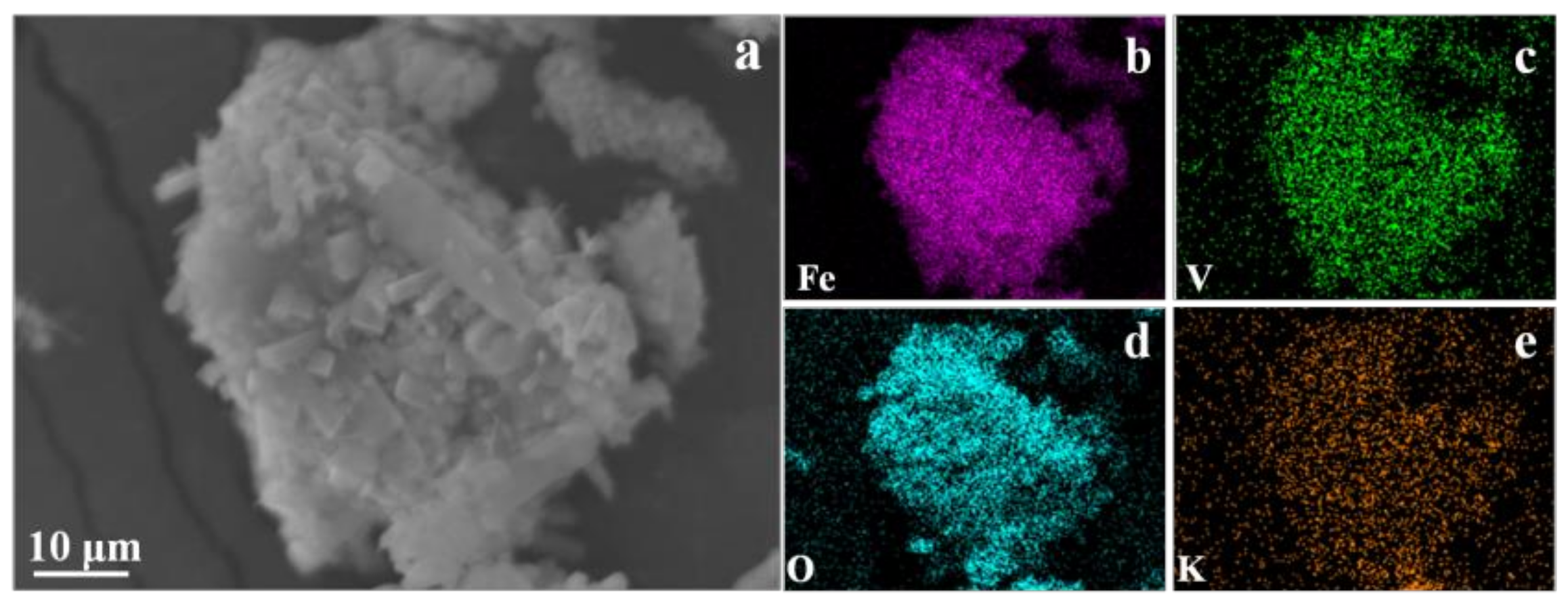
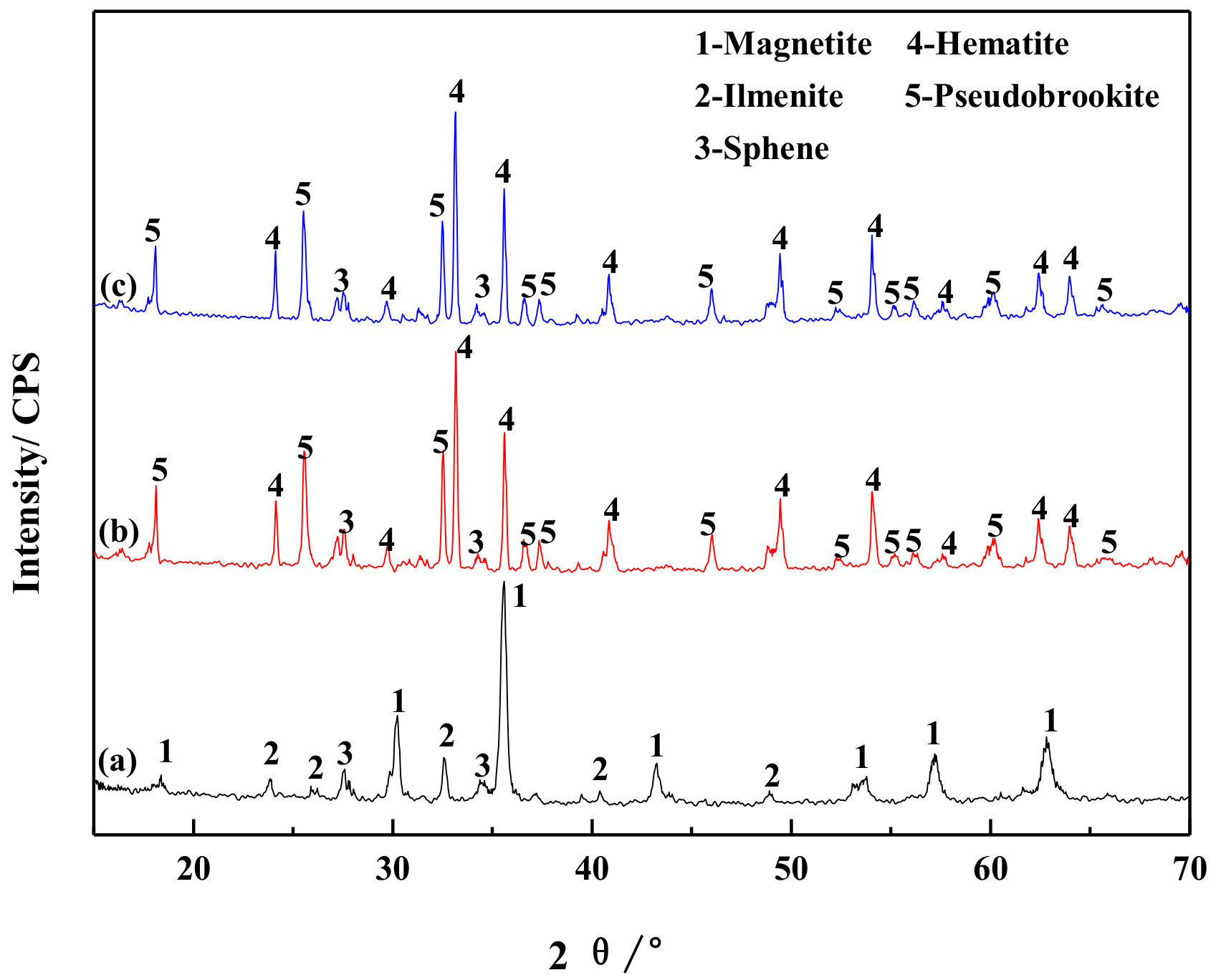
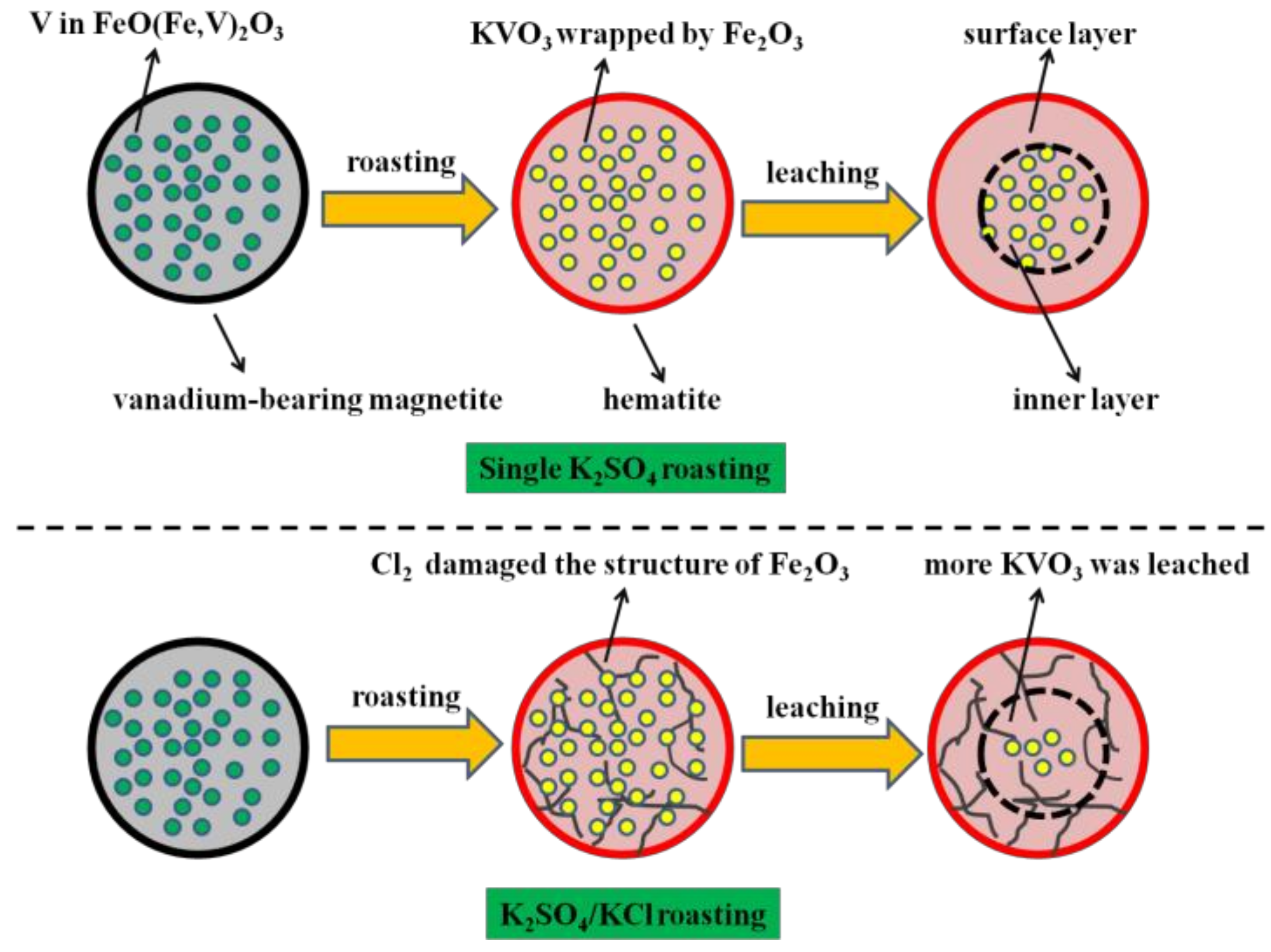
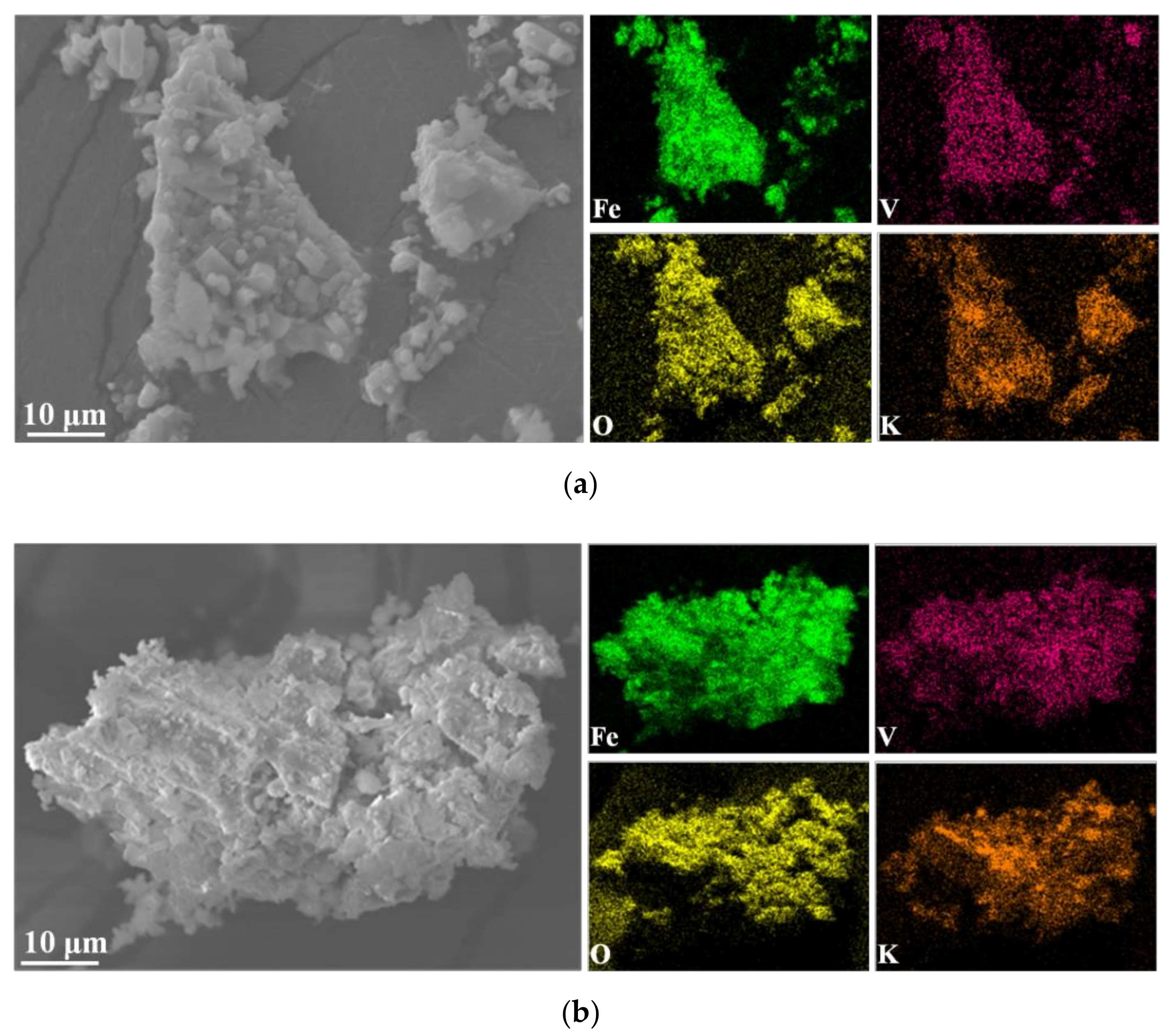
| Element | V2O5 | TiO2 | TFe | SiO2 | Al2O3 | CaO | MgO | SO3 | P2O5 |
|---|---|---|---|---|---|---|---|---|---|
| Content | 1.10 | 19.72 | 44.2 | 9.85 | 3.14 | 4.71 | 0.78 | 0.065 | 0.062 |
| Vanadium Phase | Magnetite (Fe3O4) | Ilmenite (FeTiO3) | Sphene (CaTiSiO4O) |
|---|---|---|---|
| Content | 63.54 | 5.47 | 30.99 |
© 2018 by the authors. Licensee MDPI, Basel, Switzerland. This article is an open access article distributed under the terms and conditions of the Creative Commons Attribution (CC BY) license (http://creativecommons.org/licenses/by/4.0/).
Share and Cite
Li, R.; Liu, T.; Zhang, Y.; Huang, J. Mechanism of Novel K2SO4/KCl Composite Roasting Additive for Strengthening Vanadium Extraction from Vanadium–Titanium Magnetite Concentrate. Minerals 2018, 8, 426. https://doi.org/10.3390/min8100426
Li R, Liu T, Zhang Y, Huang J. Mechanism of Novel K2SO4/KCl Composite Roasting Additive for Strengthening Vanadium Extraction from Vanadium–Titanium Magnetite Concentrate. Minerals. 2018; 8(10):426. https://doi.org/10.3390/min8100426
Chicago/Turabian StyleLi, Renmin, Tao Liu, Yimin Zhang, and Jing Huang. 2018. "Mechanism of Novel K2SO4/KCl Composite Roasting Additive for Strengthening Vanadium Extraction from Vanadium–Titanium Magnetite Concentrate" Minerals 8, no. 10: 426. https://doi.org/10.3390/min8100426
APA StyleLi, R., Liu, T., Zhang, Y., & Huang, J. (2018). Mechanism of Novel K2SO4/KCl Composite Roasting Additive for Strengthening Vanadium Extraction from Vanadium–Titanium Magnetite Concentrate. Minerals, 8(10), 426. https://doi.org/10.3390/min8100426




